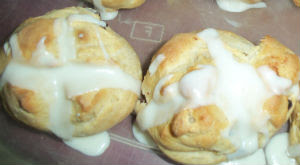 |
Cut homemade marshmallows to fit your graham crackers
for perfect S'mores.
|
Homemade Candy: Marshmallows
Just in time for Easter, here's a recipe for ersatz Peeps. Even though you won't be able to create 3-D marshmallow confections, you will be able to make fresh, melt in the mouth marshmallows. These can be cut into Easter-themed shapes using cookie cutters, dipped in chocolate or colored and flavored using essential oils or extracts.
Homemade marshmallows are confectionery blank slates, ready to be modified to fit the occasion.
This recipe does demand a little precision when making the sugar syrup. Have a candy thermometer on hand, or if you are skilled at this, do the "firm ball" test by dropping half a teaspoon of the hot syrup into a cup of cold water. If the syrup forms a ball that you can lift out of the water and squish between your fingers, then the syrup has reached the "firm ball" stage and is ready to use.
It is also helpful to use a stand mixer that has a whip attachment. As the syrup is mixed into the softened gelatin, air is whipped into the marshmallow mixture. This is what gives it the light and airy texture that characterizes marshmallows.
Finally, if you plan on cutting the marshmallows into shapes, spread the mixture onto prepared baking sheets to a thickness of 1/4" to 3/8". This should accommodate most cookie cutters and allow the marshmallows to be shaped cleanly. If you cure the marshmallow mixture in a 13 x 9 baking pan, it is best just to cut the mixture into cubes. They will be too thick to cut with cookie cutters and end up looking like little mushrooms.
Marshmallows
3 pks (1/4 oz ea) unflavored gelatin
1/2 c. cold water
2 c granulated sugar
2/3 c light corn syrup
1/2 c. water
1/4 tsp. salt
2 tsp. vanilla extract, OR 1/4 tsp. essential oil flavoring
paste food coloring, if desired
1 c. confectioners sugar
In the large mixing bowl of your stand mixer, dissolve the gelatin in 1/2 c. cold water. Allow to soften for at least 15 minutes.
Combine 1/2 c water, granulated sugar, corn syrup and salt in a large, microwave-safe bowl. Cover with cling wrap and heat for 2 1/2 minutes on high power.
Carefully remove the cling wrap from the hot sugar mixture and stir mixture gently with a wooden spoon. Cover with a new piece of cling wrap, return to microwave oven and heat for an additional 2 minutes. By this time, the syrup should be bubbling and all sugar should be dissolved. Test the temperature using a candy thermometer, or do the "firm ball" test. The syrup is done when it reaches 240 degrees or creates a firm ball when a small amount is dropped into a cup of cold water.
Using the whip attachment, begin slowly beating the softened gelatin. Slowly pour the hot syrup into the gelatin mixture, increasing the mixer speed to high or whip speed. Whip gelatin mixture for 10 to 15 minutes, or until the mixture becomes very thick and glossy. Add flavoring and coloring and beat an additional 1 minute.
Prepare a baking sheet or 13 x 9 baking pan by lining with aluminum foil and spraying the foil with nonstick cooking spray. Pour the marshmallow mixture onto the foil, using a moistened spatula to spread evenly. Allow to cure uncovered for 4 hours at room temperature. The mixture will firm up considerably and lose much of its gloss.
Sprinkle cured marshmallow mixture with 1/3 c. sifted confectioners sugar. Use the foil to lift marshmallow mixture out of the pan, then invert onto surface coated with confectioners sugar. Sprinkle bottom of marshmallows with 1/3 c. confectioners sugar. Cut into cubes or use cookie cutters to create shapes; roll cut edges in confectioners sugar.
Store marshmallows in airtight container at room temperature.






















